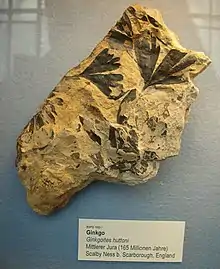Ginkgoites
Ginkgoites is a genus that refers to extinct plants belonging to Ginkgoaceae. Fossils of these plants have been found around the globe during the Triassic, Jurassic and Cretaceous. The name was created as a form genus in 1919 by Albert Seward who stated: "I ... propose to employ the name Ginkgoites for leaves that it is believed belong either to plants generically identical with Ginkgo or to very closely allied types".[1]
| Ginkgoites | |
|---|---|
 | |
| fossil leaves identified as Gingkoites | |
| Scientific classification | |
| Kingdom: | Plantae |
| Clade: | Tracheophytes |
| Division: | Ginkgophyta |
| Class: | Ginkgoopsida |
| Order: | Ginkgoales |
| Family: | Ginkgoaceae |
| Genus: | †Ginkgoites |
| Species | |
| |
Distribution
- In Paleorrota geopark in Brazil. Upper Triassic period, the Santa Maria Formation.[2]
References
- Albert Charles Seward (1919), Fossil plants: for students of botany and geology, 4, Cambridge University Press, p. 10, doi:10.5962/bhl.title.54901
- Passo das Tropas, Santa Maria, RS. Marco bioestratigráfico triássico na evolução paleoflorística do Gondwana na Bacia do Paraná
This article is issued from Wikipedia. The text is licensed under Creative Commons - Attribution - Sharealike. Additional terms may apply for the media files.